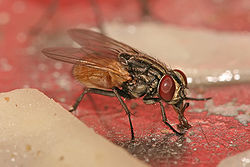| Musca | |
|---|---|
 | |
| Musca domestica (housefly) | |
| Scientific classification | |
| Kingdom: | Animalia |
| Phylum: | Arthropoda |
| Class: | Insecta |
| Order: | Diptera |
| Family: | Muscidae |
| Subfamily: | Muscinae |
| Tribe: | Muscini |
| Genus: | Musca Linnaeus, 1758 |
| Type species | |
| M. domestica | |
| Species | |
See text | |
| Synonyms | |
| |
Musca is a genus of flies. It includes Musca domestica (the housefly), as well as Musca autumnalis (the face fly or autumn housefly). It is part of the family Muscidae.



